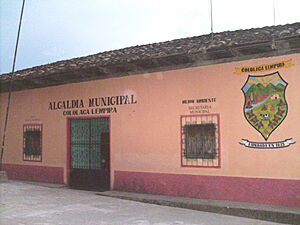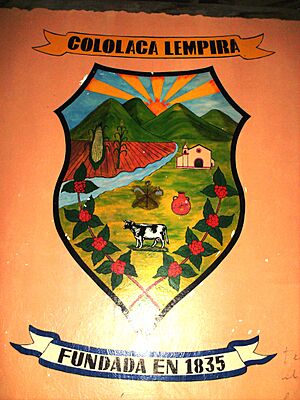Cololaca facts for kids
Quick facts for kids
Cololaca
|
|
|---|---|
|
Municipality
|
|

Central Park of Cololaca
|
|
| Country | Honduras |
| Department | Lempira |
| Municipality since | 1835 |
| Area | |
| • Total | 221 km2 (85 sq mi) |
| Population
(2015)
|
|
| • Total | 9,093 |
| • Density | 41.14/km2 (106.56/sq mi) |
| Climate | Aw |
Cololaca is a special kind of town called a municipality in Honduras. It's part of the Lempira department, which is like a state or province.
Cololaca is quite far from the city of Gracias, about 200 kilometers away. You can also get there by taking a turn off the main road in San Marcos de Ocotepeque. This path is not paved yet, but the government is working to make it a smooth road. It takes about 30 minutes to drive from San Marcos de Ocotepeque to Cololaca on this road.
Contents
History of Cololaca
Cololaca began as a private piece of land in 1628. Old stories from people who lived there say that it officially became a municipality in 1835. It was created from the Guarita district.
Geography and Nature
The forests around Cololaca are known as Dry Subtropical forests. This means they don't get a lot of water for part of the year. But when the rainy season comes, everything turns green and lively! The area has many tall, steep hills. There are also lots of good spots for raising cattle.
Where Cololaca Is Located
Cololaca shares its borders with several other places:
- North: The municipality of San Marcos de Caiquin
- South: The municipality of Guarita
- East: The municipalities of San Sebastián and Guarita
- West: The Ocotepeque department and the country of El Salvador
- Size: Cololaca covers an area of 221 square kilometers.
What Cololaca Produces
Because of the land and height, coffee plants don't grow well here. However, people in Cololaca still prepare coffee beans by peeling, drying, and roasting them. Growing corn and beans is very important for the people. They also grow vegetables to sell and use locally. Raising cattle and making milk products are common activities. Since Cololaca is close to San Marcos de Ocotepeque, there's a lot of trade between the two towns. San Marcos de Ocotepeque is a main supplier for Cololaca.
People of Cololaca
The people of Cololaca are mostly a mix of native Indigenous groups and Spanish settlers.
- Population Size: In 2001, about 5,531 people lived here. By 2008, it was estimated to be around 6,498 people. In 2015, the population was 9,093.
- Villages: There are 5 main villages in Cololaca.
- Smaller Settlements: There are also 113 smaller communities.
Who Lives Here?
According to a census in 2013, Cololaca had 8,532 people. Most of them (about 98%) were Mestizo, which means they have mixed Indigenous and European backgrounds. A smaller part (about 1%) were Indigenous, mainly from the Lenca group. There were also small numbers of Black or Afro-Honduran and White people.
Visiting Cololaca
Cololaca has a classic colonial town design. The town has electricity and mobile phone service. There aren't many hotels in Cololaca itself. However, the nearby town of San Marcos de Ocotepeque has good places to stay and fun things to do.
- Local Holidays: People in Cololaca celebrate "Dia de la Candelaria" on February 2nd.
Gallery
See also
 In Spanish: Cololaca para niños
In Spanish: Cololaca para niños







